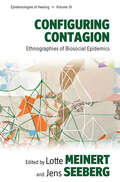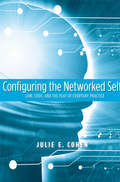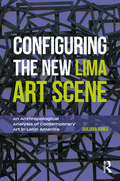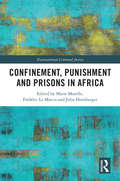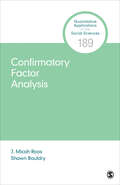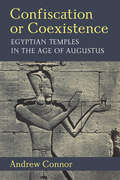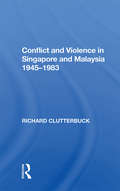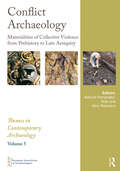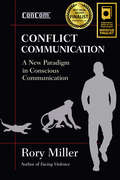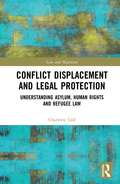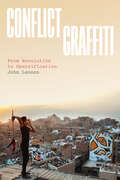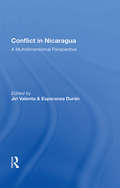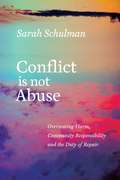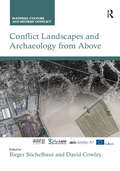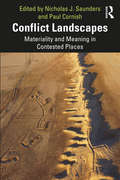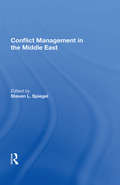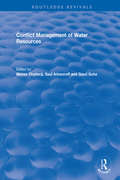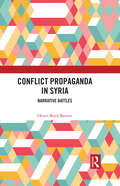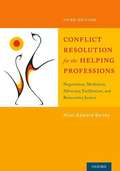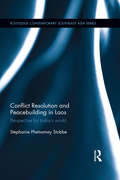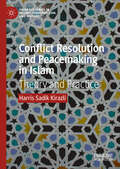- Table View
- List View
Configuring Contagion: Ethnographies of Biosocial Epidemics (Epistemologies of Healing #19)
by Lotte Meinert Jens SeebergExpanding our understanding of contagion beyond the typical notions of infection and pandemics, this book widens the field to include the concept of biosocial epidemics. The chapters propose varied and detailed answers to questions about epidemics and their contagious potential for specific infections and non-infectious conditions. Together they explore how inseparable social and biological processes configure co-existing influences, which create epidemics, and in doing so stress the role of social inequality in these processes. The authors compellingly show that epidemics do not spread evenly in populations or through simple coincidental biological contagion: they are biosocially structured and selective, and happen under specific economic, political and environmental conditions. This volume illustrates that an understanding of biosocial factors is vital for ensuring effective strategies for the containment of epidemics.
Configuring Contagion: Ethnographies of Biosocial Epidemics (Epistemologies of Healing #19)
by Lotte Meinert Jens SeebergExpanding our understanding of contagion beyond the typical notions of infection and pandemics, this book widens the field to include the concept of biosocial epidemics. The chapters propose varied and detailed answers to questions about epidemics and their contagious potential for specific infections and non-infectious conditions. Together they explore how inseparable social and biological processes configure co-existing influences, which create epidemics, and in doing so stress the role of social inequality in these processes. The authors compellingly show that epidemics do not spread evenly in populations or through simple coincidental biological contagion: they are biosocially structured and selective, and happen under specific economic, political and environmental conditions. This volume illustrates that an understanding of biosocial factors is vital for ensuring effective strategies for the containment of epidemics.
Configuring the Networked Self
by Julie E. CohenThe legal and technical rules governing flows of information are out of balance, argues Julie E. Cohen in this original analysis of information law and policy. Flows of cultural and technical information are overly restricted, while flows of personal information often are not restricted at all. The author investigates the institutional forces shaping the emerging information society and the contradictions between those forces and the ways that people use information and information technologies in their everyday lives. She then proposes legal principles to ensure that people have ample room for cultural and material participation as well as greater control over the boundary conditions that govern flows of information to, from, and about them.
Configuring the New Lima Art Scene: An Anthropological Analysis of Contemporary Art in Latin America
by Giuliana BoreaThis book examines the contemporary art world in Latin America from an anthropological perspective and recognises the recent reconfiguration of Lima's art scene. Giuliana Borea traces the practices of artists, curators, collectors, art dealers and museums, identifying three key moments in this reconfiguration of contemporary art in Lima: artistic explorations and new curatorial narratives; museum reinforcement and the strengthening of Latin American art networks; and of the rise of the art market. In so doing, Borea highlights the different actors that come into play in activating and de-activating, directions and imaginations. The book exposes the practices of the local, the global, indigeneity and politics in the arts, and reveals that the strengthening of the Lima art scene has fostered the expansion of dominant art views and formats mobilised by transnational elite actors. Featuring analytical chapters interspersed with personal stories, Borea's book presents an in-depth analysis of a specific art scene to open up a new way of understanding contemporary art practices in relation to globalisation, neoliberalism and the city.
Confinement, Punishment and Prisons in Africa (Transnational Criminal Justice)
by Marie Morelle, Frédéric Le Marcis and Julia HornbergerThis interdisciplinary volume presents a nuanced critique of the prison experience in diverse detention facilities across Africa. The book stresses the contingent, porous nature of African prisons, across both time and space. It draws on original long-term ethnographic research undertaken in both Francophone and Anglophone settings, which are grouped in four parts. The first part examines how the prison has imprinted itself on wider political and social imaginaries and, in turn, how structures of imprisonment carry the imprint of political action of various times. The second part stresses how particular forms of ordering emerge in African prisons. It is held that while these often involve coercion and neglect, they are better understood as the product of on-going negotiations and the search for meaning and value on the part of a multitude of actors. The third part is concerned with how prison life percolates beyond its physical perimeters into its urban and rural surroundings, and vice versa. It deals with the popular and contested nature of what prisons are about and what they do, especially in regard to bringing about moral subjects. The fourth and final part of the book examines how efforts of reforming and resisting the prison take shape at the intersection of globally circulating models of good governance and levels of self-organisation by prisoners. The book will be an essential reference for students, academics and policy-makers in Law, Criminology, Sociology and Politics.
Confirmatory Factor Analysis (Quantitative Applications in the Social Sciences)
by J. Micah Roos Shawn BauldryMeasurement connects theoretical concepts to what is observable in the empirical world, and is fundamental to all social and behavioral research. In this volume, J. Micah Roos and Shawn Bauldry introduce a popular approach to measurement: Confirmatory Factor Analysis (CFA). As the authors explain, CFA is a theoretically informed statistical framework for linking multiple observed variables to latent variables that are not directly measurable. The authors begin by defining terms, introducing notation, and illustrating a wide variety of measurement models with different relationships between latent and observed variables. They proceed to a thorough treatment of model estimation, followed by a discussion of model fit. Most of the volume focuses on measures that approximate continuous variables, but the authors also devote a chapter to categorical indicators. Each chapter develops a different example (sometimes two) covering topics as diverse as racist attitudes, theological conservatism, leadership qualities, psychological distress, self-efficacy, beliefs about democracy, and Christian nationalism drawn mainly from national surveys. Data to replicate the examples are available on a companion website, along with code for R, Stata, and Mplus.
Confirmatory Factor Analysis (Quantitative Applications in the Social Sciences)
by J. Micah Roos Shawn BauldryMeasurement connects theoretical concepts to what is observable in the empirical world, and is fundamental to all social and behavioral research. In this volume, J. Micah Roos and Shawn Bauldry introduce a popular approach to measurement: Confirmatory Factor Analysis (CFA). As the authors explain, CFA is a theoretically informed statistical framework for linking multiple observed variables to latent variables that are not directly measurable. The authors begin by defining terms, introducing notation, and illustrating a wide variety of measurement models with different relationships between latent and observed variables. They proceed to a thorough treatment of model estimation, followed by a discussion of model fit. Most of the volume focuses on measures that approximate continuous variables, but the authors also devote a chapter to categorical indicators. Each chapter develops a different example (sometimes two) covering topics as diverse as racist attitudes, theological conservatism, leadership qualities, psychological distress, self-efficacy, beliefs about democracy, and Christian nationalism drawn mainly from national surveys. Data to replicate the examples are available on a companion website, along with code for R, Stata, and Mplus.
Confiscation or Coexistence: Egyptian Temples in the Age of Augustus (New Texts From Ancient Cultures)
by Andrew ConnorIt is generally accepted that Roman administrators, arriving in Egypt in the aftermath of Augustus’ annexation of the province, confiscated en masse the land and other property belonging to the temples of Egypt—estimated at as much as one-third of the country. It is further accepted that this confiscation doomed the temples by removing their economic support and making them subservient to the Roman state, and that this in turn led to the collapse of Egyptian religion. In Confiscation or Coexistence: Egyptian Temples in the Age of Augustus, author Andrew Connor takes direct issue with both claims. The interpretative consensus developed after the publication of a handful of key documents—P.Tebt. 2.302 especially, alongside BGU 4.1198 and 1200, and P.Berl.Leihg. 1.5. Connor offers a fundamentally revised interpretation of these texts, building from a fresh examination of the papyri themselves. The book frames the interpretation in a wider discussion of Roman interactions with Egyptian religion, including material from inside and outside Egypt, and locates the development of an interpretative consensus in early 20th-century scholarship within the wider context of empire and colonization at the time. In doing so, Connor explores these papyri through their historical, intellectual, and linguistic contexts, alongside a number of other important texts bearing on the relationship between the temples and the Roman state.
Conflict And Violence In Singapore And Malaysia, 1945-1983
by Richard ClutterbuckIs there a risk that Malaysia's racial mixture and its weighted political and economic structures could again explode into the kind of violence which, in 1969, was only just prevented from setting the whole country on fire? And has Singapore's success been bought at a price in civil liberties too high for its health in the future? Four years of th
Conflict Archaeology: Materialities of Collective Violence from Prehistory to Late Antiquity (Themes in Contemporary Archaeology)
by Manuel Fernández-Götz Nico RoymansIn the past two decades, conflict archaeology has become firmly established as a promising field of research, as reflected in publications, symposia, conference sessions and fieldwork projects. It has its origins in the study of battlefields and other conflict-related phenomena in the modern Era, but numerous studies show that this theme, and at least some of its methods, techniques and theories, are also relevant for older historical and even prehistoric periods. This book presents a series of case-studies on conflict archaeology in ancient Europe, based on the results of both recent fieldwork and a reassessment of older excavations. The chronological framework spans from the Neolithic to Late Antiquity, and the geographical scope from Iberia to Scandinavia. Along key battlefields such as the Tollense Valley, Baecula, Alesia, Kalkriese and Harzhorn, the volume also incorporates many other sources of evidence that can be directly related to past conflict scenarios, including defensive works, military camps, battle-related ritual deposits, and symbolic representations of violence in iconography and grave goods. The aim is to explore the material evidence for the study of warfare, and to provide new theoretical and methodological insights into the archaeology of mass violence in ancient Europe and beyond.
Conflict Communication: A New Paradigm in Conscious Communication
by Rory MillerYour reactions to conflict are subconscious, scripted, and for the good of the group. Conflict happens everywhere: at work, with friends and family, among strangers, and certainly in violence. Why did your boss ignore a suggestion that could save millions of dollars? Why do you have the same argument again and again with your spouse? When someone insults you, why do you get angry? Why do bad guys beat up the weak? You have three brains. * Lizard brain (survival) * Monkey brain (emotion / social status) * Human brain (reason) Each "brain" has a different priority and evolved to deal with different kinds of conflict. They work using different scripts and have a very clear seniority system. Conflict Communication (ConCom) presents a functional taxonomy to see, understand, and manipulate the roots of life's conflicts. You will have the background, the principles, and a collection of tricks to manage and ideally avoid dangerous conflicts. No going back. After reading this book, you can never go back. Even if you reject everything in the program, even if you refuse to admit how often your monkey brain has controlled your life, escalations toward conflict will never again be invisible to you. As the fortune cookie says, "Your life is about to change."
Conflict Displacement and Legal Protection: Understanding Asylum, Human Rights and Refugee Law (Law and Migration)
by Charlotte LülfWhile the 21st century bears witness to several conflicts leading to mass displacement, the conflict in Syria has crystallised the need for a solid legal framework and legal certainty. This book analyses the relevant legal instruments for the provision of a protection status for persons fleeing to Europe from conflict and violence. It focuses on the conceptualisation of conflict and violence in the countries of origin and the different approaches taken in the interpretation of them in the 1951 Refugee Convention, the Recast Qualification Directive of the European Union and the European Convention on Human Rights. It traces the hierarchical order of protection granted, starting with refugee protection status, to subsidiary protection status and finally with the negative protection from non-refoulement. Recent case law and asylum status determination practices of European countries illustrate the obstacles in the interpretation as well as the divergence in the application of the legal instruments. The book fills an important gap in examining the current practices of key actors, including the United Nations High Commissioner for Refugees and European states, tracing changes in national and international policies and revealing discrepancies towards contemporary approaches to conflicts. It refines the interaction and cross-fertilisation of the different relevant fields of European asylum law, human rights law and the laws of armed conflict in order to further the development of a harmonised protection regime for conflict-induced displacement.
Conflict Graffiti: From Revolution to Gentrification
by John LennonThis study examines the waves of graffiti that occur before, during, and after a conflict—important tools of political resistance that make protest visible and material. Graffiti makes for messy politics. In film and television, it is often used to create a sense of danger or lawlessness. In bathroom stalls, it is the disembodied expression of gossip, lewdness, or confession. But it is also a resistive tool of protest, making visible the disparate voices and interests that come together to make a movement. In Conflict Graffiti, John Lennon dives into the many permutations of graffiti in conflict zones—ranging from the protest graffiti of the Black Lives Matter movement in Ferguson and the Tahrir Square demonstrations in Egypt, to the tourist-attraction murals on the Israeli Separation Wall and the street art that has rebranded Detroit and post-Katrina New Orleans. Graffiti has played a crucial role in the revolutionary movements of these locales, but as the conflict subsides a new graffiti and street art scene emerges—often one that ushers in postconflict consumerism, gentrification, militarization, and anesthetized forgetting. Graffiti has an unstable afterlife, fated to be added to, transformed, overlaid, photographed, reinterpreted, or painted over. But as Lennon concludes, when protest movements change and adapt, graffiti is also uniquely suited to shapeshift with them.
Conflict Graffiti: From Revolution to Gentrification
by John LennonThis study examines the waves of graffiti that occur before, during, and after a conflict—important tools of political resistance that make protest visible and material. Graffiti makes for messy politics. In film and television, it is often used to create a sense of danger or lawlessness. In bathroom stalls, it is the disembodied expression of gossip, lewdness, or confession. But it is also a resistive tool of protest, making visible the disparate voices and interests that come together to make a movement. In Conflict Graffiti, John Lennon dives into the many permutations of graffiti in conflict zones—ranging from the protest graffiti of the Black Lives Matter movement in Ferguson and the Tahrir Square demonstrations in Egypt, to the tourist-attraction murals on the Israeli Separation Wall and the street art that has rebranded Detroit and post-Katrina New Orleans. Graffiti has played a crucial role in the revolutionary movements of these locales, but as the conflict subsides a new graffiti and street art scene emerges—often one that ushers in postconflict consumerism, gentrification, militarization, and anesthetized forgetting. Graffiti has an unstable afterlife, fated to be added to, transformed, overlaid, photographed, reinterpreted, or painted over. But as Lennon concludes, when protest movements change and adapt, graffiti is also uniquely suited to shapeshift with them.
Conflict Graffiti: From Revolution to Gentrification
by John LennonThis study examines the waves of graffiti that occur before, during, and after a conflict—important tools of political resistance that make protest visible and material. Graffiti makes for messy politics. In film and television, it is often used to create a sense of danger or lawlessness. In bathroom stalls, it is the disembodied expression of gossip, lewdness, or confession. But it is also a resistive tool of protest, making visible the disparate voices and interests that come together to make a movement. In Conflict Graffiti, John Lennon dives into the many permutations of graffiti in conflict zones—ranging from the protest graffiti of the Black Lives Matter movement in Ferguson and the Tahrir Square demonstrations in Egypt, to the tourist-attraction murals on the Israeli Separation Wall and the street art that has rebranded Detroit and post-Katrina New Orleans. Graffiti has played a crucial role in the revolutionary movements of these locales, but as the conflict subsides a new graffiti and street art scene emerges—often one that ushers in postconflict consumerism, gentrification, militarization, and anesthetized forgetting. Graffiti has an unstable afterlife, fated to be added to, transformed, overlaid, photographed, reinterpreted, or painted over. But as Lennon concludes, when protest movements change and adapt, graffiti is also uniquely suited to shapeshift with them.
Conflict In Nicaragua: A Multidimensional Perspective
by Jiri ValentaThe issue of Nicaragua arouses political passions, those that we see expressed almost daily in the newspapers of Europe, Latin America, and the United States. Few issues are more divisive within the politics of certain countries, and the evolution of the Nicaraguan drama threatens to drive a wedge between countries that are friends, allies, and par
Conflict Is Not Abuse: Overstating Harm, Community Responsibility, and the Duty of Repair
by Sarah SchulmanFrom intimate relationships to global politics, Sarah Schulman observes a continuum: that inflated accusations of harm are used to avoid accountability. Illuminating the difference between Conflict and Abuse, Schulman directly addresses our contemporary culture of scapegoating. This deep, brave, and bold work reveals how punishment replaces personal and collective self-criticism, and shows why difference is so often used to justify cruelty and shunning. Rooting the problem of escalation in negative group relationships, Schulman illuminates the ways cliques, communities, families, and religious, racial, and national groups bond through the refusal to change their self-concept. She illustrates how Supremacy behavior and Traumatized behavior resemble each other, through a shared inability to tolerate difference.This important and sure to be controversial book illuminates such contemporary and historical issues of personal, racial, and geo-political difference as tools of escalation towards injustice, exclusion, and punishment, whether the objects of dehumanization are other individuals in our families or communities, people with HIV, African Americans, or Palestinians. Conflict Is Not Abuse is a searing rejection of the cultural phenomenon of blame, cruelty, and scapegoating, and how those in positions of power exacerbate and manipulate fear of the "other" to achieve their goals.Sarah Schulman is a novelist, nonfiction writer, playwright, screenwriter, journalist and AIDS historian, and the author of eighteen books. A Guggenheim and Fulbright Fellow, Sarah is a Distinguished Professor of the Humanities at the City University of New York, College of Staten Island. Her novels published by Arsenal include Rat Bohemia, Empathy, After Delores, and The Mere Future. She lives in New York.
Conflict Landscapes and Archaeology from Above (Material Culture and Modern Conflict)
by Birger Stichelbaut David CowleyThe study of conflict archaeology has developed rapidly over the last decade, fuelled in equal measure by technological advances and creative analytical frameworks. Nowhere is this truer than in the inter-disciplinary fields of archaeological practice that combine traditional sources such as historical photographs and maps with 3D digital topographic data from Airborne Laser Scanning (ALS) and large scale geophysical prospection. For twentieth-century conflict landscapes and their surviving archaeological remains, these developments have encouraged a shift from a site oriented approach towards landscape-scaled research. This volume brings together an wide range of perspectives, setting traditional approaches that draw on historical and contemporary aerial photographs alongside cutting-edge prospection techniques, cross-disciplinary analyses and innovative methods of presenting this material to audiences. Essays from a range of disciplines (archaeology, history, geography, heritage and museum studies) studying conflict landscapes across the globe throughout the twentieth century, all draw on aerial and landscape perspectives to past conflicts and their legacy and the complex issues for heritage management. Organized in four parts, the first three sections take a broadly chronological approach, exploring the use of aerial evidence to expand our understanding of the two World Wars and the Cold War. The final section explores ways that the aerial perspective can be utilized to represent historical landscapes to a wide audience. With case studies ranging from the Western Front to the Cold War, Ireland to Russia, this volume demonstrates how an aerial perspective can both support and challenge traditional archaeological and historical analysis, providing an innovative new means of engaging with the material culture of conflict and commemoration.
Conflict Landscapes: Materiality and Meaning in Contested Places
by Nicholas J. Saunders and Paul CornishConflict Landscapes explores the long under-acknowledged and under-investigated aspects of where and how modern conflict landscapes interact and conjoin with pre-twentieth-century places, activities, and beliefs, as well as with individuals and groups. Investigating and understanding the often unpredictable power and legacies of landscapes that have seen (and often still viscerally embody) the consequences of mass death and destruction, the book shows, through these landscapes, the power of destruction to preserve, refocus, and often reconfigure the past. Responding to the complexity of modern conflict, the book offers a coherent, integrated, and sensitized hybrid approach, which calls on different disciplines where they overlap in a shared common terrain. Dealing with issues such as memory, identity, emotion, and wellbeing, the chapters tease out the human experience of modern conflict and its relationship to landscape. Conflict Landscapes will appeal to a wide range of disciplines involved in studying conflict, such as archaeology, anthropology, material culture studies, art history, cultural history, cultural geography, military history, and heritage and museum studies.
Conflict Management In The Middle East
by Steven L SpiegelThis book explores efforts being made to create Russian-American cooperation in managing recurrent conflict in the Middle East. Theoretical, historical, and policy sections provide the framework for chapters that represent the most current, multinational thinking on issues of war prevention, crisis avoidance, and conflict resolution. The contributo
Conflict Management of Water Resources (Routledge Revivals)
by Manas Chatterji Saul Arlosoroff Gauri GuhaThis title was first published in 2002: Now that the Cold War is over, ethnic and regional conflicts are emerging over resources and the environment. The management of water, the lifeblood of any country, is becoming a vital issue. This volume offers a study of conflict management of water resources. It includes some selected papers presented at an international meeting, held at the Mahatma Gandhi Center of Conflict Prevention and Management in Ahmedabad, India. Other invited papers have also been included in the collection. Obviously it was not possible to address here all aspects of the vast field of water management. The main focus of this work is the management of water conflict and its implications for peace.
Conflict Propaganda in Syria: Narrative Battles
by Oliver Boyd-BarrettThis book investigates rival narratives about the conflict in Syria from 2011 onwards. It examines the starkly different narratives about the Syrian conflict told by mainly Western mainstream and alternative media, and contrasts these narratives with the equally polarized but more nuanced narratives of mainly western scholars and long-form journalists. Differences of narrative concerning the conflict include: what is deemed relevant context in trying to explain the war; whether the war is best seen as a civil conflict or as a proxy war fought among external powers; the degree of emphasis given to the alleged crimes of the Syrian regime as opposed to the alleged violence of Salafist militia; the accuracy of the "origin" story of the conflict in Daraa; the extent to which the initial protestors were secular campaigners calling for democracy or whether they were Muslim extremists seeking a sectarian society governed by sharia law. Several case studies of propaganda institutions are examined here, including the journalism of Marie Colvin; the role of government-funded NGOs; the controversies surrounding each of three major instances of alleged regime use of chemical weapons, and the politicization of the Organization for the Prohibition of Chemical Weapons (OPCW). This book will be of much interest to students of media and communication studies, propaganda studies, Middle Eastern politics, and International Relations in general.
Conflict Resolution For The Helping Professions: Negotiation, Mediation, Advocacy, Facilitation, and Restorative Justice
by Allan Edward BarskyWhen people think of conflict, they often think of fights, wars, arguments, hot tempers, and hurtful consequences. This book provides helping professionals with the theory, strategies, and skills they need to deal with conflict in a manner that is respectful, collaborative, and constructive. This text illustrates how helping professionals can incorporate evidence-based models of conflict resolution to work more effectively and enjoyably with clients, coworkers, supervisors, and others. Practitioners will learn how to respond effectively when others use power, positions, and competition. Whereas many conflict resolution texts focus on one method or approach to practice, this textbook provides practitioners with various models that they can incorporate in their roles as negotiators, counselors, mediators, facilitators, advocates, and peacebuilders.
Conflict Resolution and Peacebuilding in Laos: Perspective for Today's World (Routledge Contemporary Southeast Asia Series)
by Stephanie Phetsamay StobbeUsing the case study of Laos, a small landlocked country in Southeast Asia that has seen some of the world’s most brutal forms of poverty and violence, this book examines the power of traditional and indigenous conflict resolution systems as a tool for social justice. It explores how the conflict resolution mechanisms build infrastructures that support social harmony, and address larger scale conflicts within communities, nations and international arenas. The book discusses how over centuries, foreign powers have polarised and used the ethnic groups of Laos to support their own agendas, and how in spite of this, the Lao people have consistently managed to recreate the peace and harmony that support their social relationships, whether that is within groups or between many distinct groups. Through the development and use of appropriate grassroots conflict resolution structures that do not require a formal court system and exists outside the political arena, they have been successful in resolving conflicts within and across cultural groups. The book shows that the conflict resolution systems of Laos are embedded in the fabric of ordinary, everyday life, and operate independently of the hierarchical structures that dominate governing institutions. Highlighting how peace continues to work its way into existence, through elaborate mediation systems and rituals that bring people together, this book will be of use to students and scholars of Southeast Asian Politics, Peace Studies and War and Conflict Studies.
Conflict Resolution and Peacemaking in Islam: Theory and Practice (Palgrave Series in Islamic Theology, Law, and History)
by Harris Sadik KirazliThe book explores Islamic perspectives on conflict resolution and peacemaking. It delves into key topics such as the principles of Islamic conflict resolution, historical examples of peaceful resolutions, and contemporary challenges faced by Muslim societies. By addressing these topics, the book aims to provide insight into Islamic teachings and practices that can contribute to building bridges and fostering peace in diverse contexts. The book is important and relevant due to the increasing need for understanding and promoting peaceful resolutions in today's world, particularly in regions influenced by Islam. It offers a comprehensive examination of the principles and methods of conflict resolution within an Islamic framework, shedding light on the rich history of peacemaking within Muslim societies. By highlighting Islamic perspectives on peace, the book aims to bridge cultural divides and foster dialogue, promoting a greater understanding and appreciation of the contributions Islam can make to conflict resolution. The book seeks to address the prevalent misconceptions and stereotypes surrounding Islam's approach to conflict resolution. It aims to challenge the notion that Islam is inherently associated with violence or lack of peaceful solutions. By presenting authentic Islamic teachings and historical examples of peaceful resolutions, the book endeavours to contribute to a more nuanced and accurate understanding of Islam's role in promoting conflict resolution and peacemaking. It offers readers an opportunity to explore Islamic perspectives on resolving conflicts, encouraging dialogue, and cultivating a more peaceful world.
